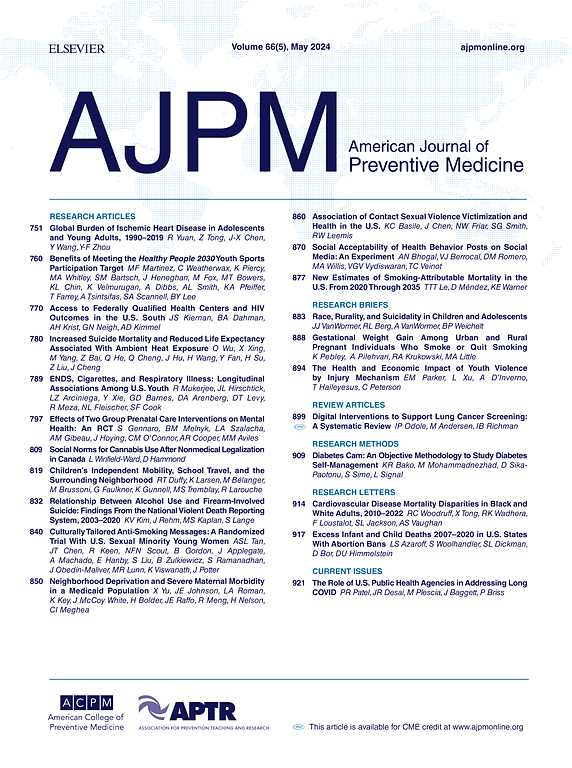Kind Kids, Healthy Teens: Child Prosociality and Fruit and Vegetable Intake
IF 4.5
2区 医学
Q1 MEDICINE, GENERAL & INTERNAL
引用次数: 0
Abstract
Introduction
Prosocial behaviors (i.e., being kind, caring, and cooperative) are believed to shape health and well-being starting in childhood. Yet, limited research has examined their long-term impact on health outcomes later in life. This study examined associations between childhood prosocial behaviors and fruit and vegetable consumption patterns across adolescence.
Methods
Participants were from the United Kingdom Millennium Cohort Study (N=6,265). Caregivers reported children’s prosocial behaviors using the Strengths and Difficulties Questionnaire at ages 5 (2005–2007), 7 (2007–2009), and 11 (2011–2013) years. In 2024, Poisson regression was conducted to assess the associations between prosocial behaviors at age 5 years and sustained healthy levels of self-reported fruit and vegetable consumption across ages 14 (2014–2016) and 17 (2017–2019) years, defined as eating ≥2 portions of each daily. To evaluate heterogeneity by developmental stage, secondary analyses considered associations with prosocial behaviors at ages 7 and 11 years. All analyses adjusted for relevant confounders.
Results
More engagement in prosocial behaviors at age 5 years was associated with a greater likelihood of sustaining healthy fruit and vegetable consumption over time (adjusted prevalence ratio per 1 SD=1.14; 95% CI=1.02, 1.27). Comparable associations were observed with prosocial behaviors at ages 7 (adjusted prevalence ratio per 1 SD=1.12; 95% CI=1.03, 1.23) and 11 (adjusted prevalence ratio per 1 SD=1.13; 95% CI=1.03, 1.24) years.
Conclusions
Greater engagement in prosocial behaviors was related to healthy fruit and vegetable consumption patterns across adolescence with comparable associations when prosocial behaviors were measured at ages 5, 7, and 11 years. These findings suggest fostering prosociality throughout childhood may be a novel intervention strategy to promote healthy eating.
善良的孩子,健康的青少年:儿童亲社会与水果和蔬菜的摄入量。
引言:亲社会行为(即善良,关心和合作)被认为从童年开始就塑造了健康和幸福。然而,有限的研究调查了它们对以后生活健康结果的长期影响。这项研究调查了童年亲社会行为与青春期水果和蔬菜消费模式之间的关系。方法:参与者来自英国千禧年队列研究(N= 6265)。照顾者在5岁(2005-2007)、7岁(2007-2009)和11岁(2011-2013)时使用优势与困难问卷报告儿童的亲社会行为。2024年,研究人员进行了泊松回归,以评估5岁时的亲社会行为与14岁(2014-2016年)和17岁(2017-2019年)自我报告的水果和蔬菜消费持续健康水平之间的关系,14岁和17岁的水果和蔬菜消费定义为每天吃≥2份。为了评估发育阶段的异质性,二级分析考虑了7岁和11岁时亲社会行为的相关性。所有分析均根据相关混杂因素进行调整。结果:5岁时亲社会行为越多,越有可能长期保持健康的水果和蔬菜消费(每1 SD调整患病率=1.14;95% ci =1.02, 1.27)。在7岁时观察到亲社会行为具有可比的相关性(校正患病率每1 SD=1.12;95% CI=1.03, 1.23)和11(校正患病率每1 SD=1.13;95% CI=1.03, 1.24)年。结论:在5岁、7岁和11岁时测量亲社会行为时,更大的亲社会行为参与与青春期健康的水果和蔬菜消费模式有关。这些发现表明,在整个童年时期培养亲社会性可能是促进健康饮食的一种新的干预策略。
本文章由计算机程序翻译,如有差异,请以英文原文为准。
求助全文
约1分钟内获得全文
求助全文
来源期刊

American Journal of Preventive Medicine
医学-公共卫生、环境卫生与职业卫生
CiteScore
8.60
自引率
1.80%
发文量
395
审稿时长
32 days
期刊介绍:
The American Journal of Preventive Medicine is the official journal of the American College of Preventive Medicine and the Association for Prevention Teaching and Research. It publishes articles in the areas of prevention research, teaching, practice and policy. Original research is published on interventions aimed at the prevention of chronic and acute disease and the promotion of individual and community health.
Of particular emphasis are papers that address the primary and secondary prevention of important clinical, behavioral and public health issues such as injury and violence, infectious disease, women''s health, smoking, sedentary behaviors and physical activity, nutrition, diabetes, obesity, and substance use disorders. Papers also address educational initiatives aimed at improving the ability of health professionals to provide effective clinical prevention and public health services. Papers on health services research pertinent to prevention and public health are also published. The journal also publishes official policy statements from the two co-sponsoring organizations, review articles, media reviews, and editorials. Finally, the journal periodically publishes supplements and special theme issues devoted to areas of current interest to the prevention community.
 求助内容:
求助内容: 应助结果提醒方式:
应助结果提醒方式:


